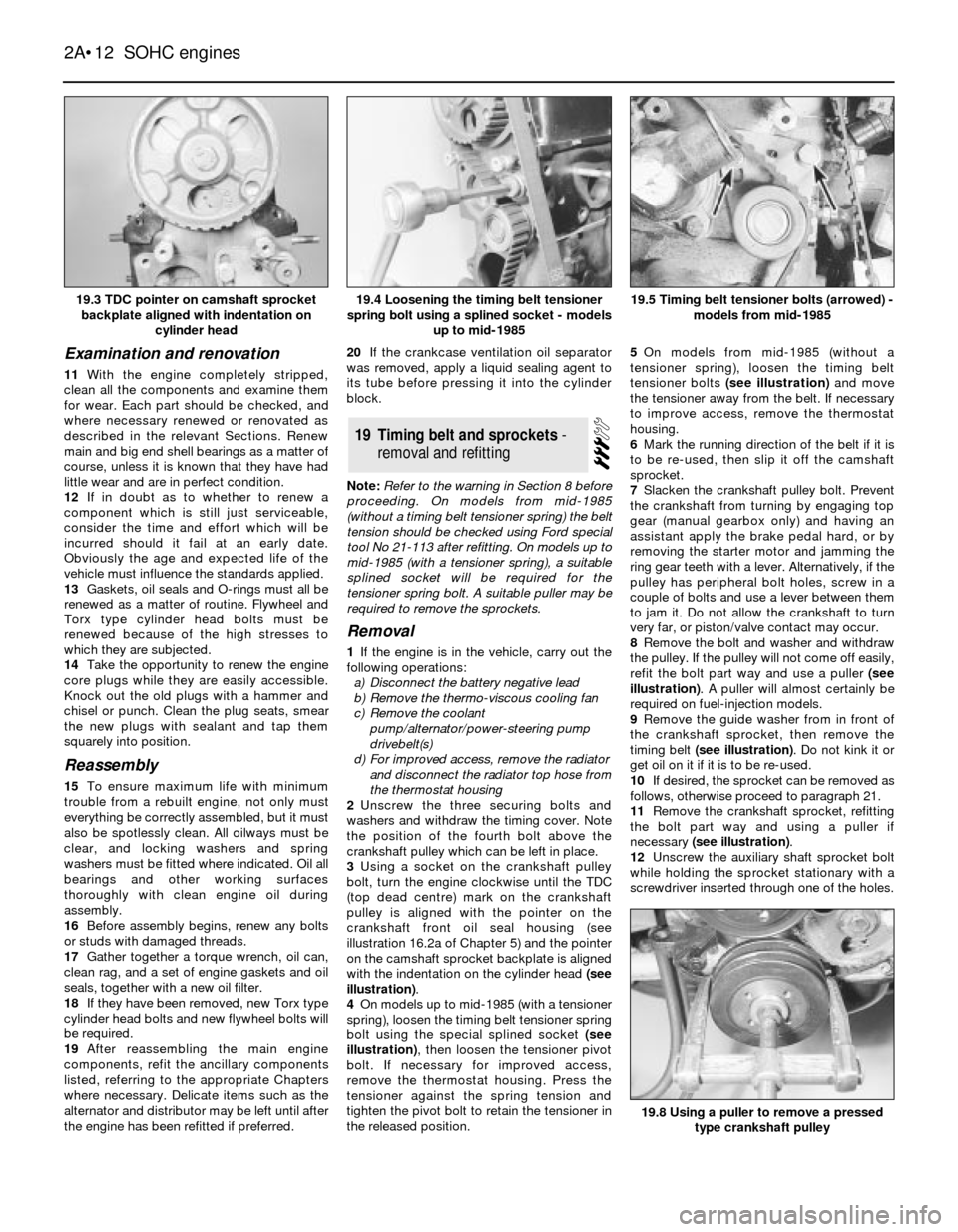set clock FORD SIERRA 1982 1.G SOHC Engines Workshop Manual
[x] Cancel search | Manufacturer: FORD, Model Year: 1982, Model line: SIERRA, Model: FORD SIERRA 1982 1.GPages: 24, PDF Size: 1.03 MB
Page 12 of 24

Examination and renovation
11With the engine completely stripped,
clean all the components and examine them
for wear. Each part should be checked, and
where necessary renewed or renovated as
described in the relevant Sections. Renew
main and big end shell bearings as a matter of
course, unless it is known that they have had
little wear and are in perfect condition.
12If in doubt as to whether to renew a
component which is still just serviceable,
consider the time and effort which will be
incurred should it fail at an early date.
Obviously the age and expected life of the
vehicle must influence the standards applied.
13Gaskets, oil seals and O-rings must all be
renewed as a matter of routine. Flywheel and
Torx type cylinder head bolts must be
renewed because of the high stresses to
which they are subjected.
14Take the opportunity to renew the engine
core plugs while they are easily accessible.
Knock out the old plugs with a hammer and
chisel or punch. Clean the plug seats, smear
the new plugs with sealant and tap them
squarely into position.
Reassembly
15To ensure maximum life with minimum
trouble from a rebuilt engine, not only must
everything be correctly assembled, but it must
also be spotlessly clean. All oilways must be
clear, and locking washers and spring
washers must be fitted where indicated. Oil all
bearings and other working surfaces
thoroughly with clean engine oil during
assembly.
16Before assembly begins, renew any bolts
or studs with damaged threads.
17Gather together a torque wrench, oil can,
clean rag, and a set of engine gaskets and oil
seals, together with a new oil filter.
18If they have been removed, new Torx type
cylinder head bolts and new flywheel bolts will
be required.
19After reassembling the main engine
components, refit the ancillary components
listed, referring to the appropriate Chapters
where necessary. Delicate items such as the
alternator and distributor may be left until after
the engine has been refitted if preferred.20If the crankcase ventilation oil separator
was removed, apply a liquid sealing agent to
its tube before pressing it into the cylinder
block.
Note: Refer to the warning in Section 8 before
proceeding. On models from mid-1985
(without a timing belt tensioner spring) the belt
tension should be checked using Ford special
tool No 21-113 after refitting. On models up to
mid-1985 (with a tensioner spring), a suitable
splined socket will be required for the
tensioner spring bolt. A suitable puller may be
required to remove the sprockets.
Removal
1If the engine is in the vehicle, carry out the
following operations:
a)Disconnect the battery negative lead
b)Remove the thermo-viscous cooling fan
c)Remove the coolant
pump/alternator/power-steering pump
drivebelt(s)
d)For improved access, remove the radiator
and disconnect the radiator top hose from
the thermostat housing
2Unscrew the three securing bolts and
washers and withdraw the timing cover. Note
the position of the fourth bolt above the
crankshaft pulley which can be left in place.
3Using a socket on the crankshaft pulley
bolt, turn the engine clockwise until the TDC
(top dead centre) mark on the crankshaft
pulley is aligned with the pointer on the
crankshaft front oil seal housing (see
illustration 16.2a of Chapter 5) and the pointer
on the camshaft sprocket backplate is aligned
with the indentation on the cylinder head (see
illustration).
4On models up to mid-1985 (with a tensioner
spring), loosen the timing belt tensioner spring
bolt using the special splined socket (see
illustration), then loosen the tensioner pivot
bolt. If necessary for improved access,
remove the thermostat housing. Press the
tensioner against the spring tension and
tighten the pivot bolt to retain the tensioner in
the released position.5On models from mid-1985 (without a
tensioner spring), loosen the timing belt
tensioner bolts (see illustration)and move
the tensioner away from the belt. If necessary
to improve access, remove the thermostat
housing.
6Mark the running direction of the belt if it is
to be re-used, then slip it off the camshaft
sprocket.
7Slacken the crankshaft pulley bolt. Prevent
the crankshaft from turning by engaging top
gear (manual gearbox only) and having an
assistant apply the brake pedal hard, or by
removing the starter motor and jamming the
ring gear teeth with a lever. Alternatively, if the
pulley has peripheral bolt holes, screw in a
couple of bolts and use a lever between them
to jam it. Do not allow the crankshaft to turn
very far, or piston/valve contact may occur.
8Remove the bolt and washer and withdraw
the pulley. If the pulley will not come off easily,
refit the bolt part way and use a puller (see
illustration). A puller will almost certainly be
required on fuel-injection models.
9Remove the guide washer from in front of
the crankshaft sprocket, then remove the
timing belt (see illustration). Do not kink it or
get oil on it if it is to be re-used.
10If desired, the sprocket can be removed as
follows, otherwise proceed to paragraph 21.
11Remove the crankshaft sprocket, refitting
the bolt part way and using a puller if
necessary (see illustration).
12Unscrew the auxiliary shaft sprocket bolt
while holding the sprocket stationary with a
screwdriver inserted through one of the holes.
19Timing belt and sprockets -
removal and refitting
2A¥12SOHC engines
19.3 TDC pointer on camshaft sprocket
backplate aligned with indentation on
cylinder head19.5 Timing belt tensioner bolts (arrowed) -
models from mid-1985
19.8 Using a puller to remove a pressed
type crankshaft pulley
19.4 Loosening the timing belt tensioner
spring bolt using a splined socket - models
up to mid-1985